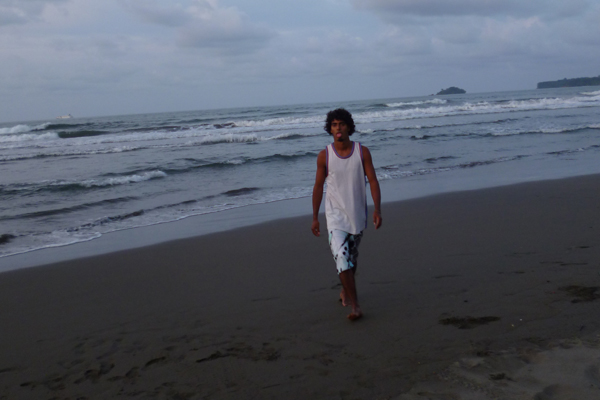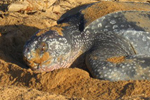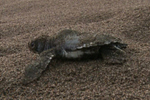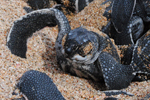
Jairo Mora Sandoval walking on the beach where he died after releasing over a hundred turtle hatchlings in 2012. Photo by: Carlyn Samuel.
On the evening of May 30th, 26-year-old Jairo Mora Sandoval was murdered on Moin beach near Limón, Costa Rica, the very stretch of sand where he courageously monitored sea turtle nests for years even as risks from poachers rose, including threats at gunpoint. A dedicated conservationist, Sandoval was kidnapped along with four women volunteers (three Americans and one from Spain) while driving along the beach looking for nesting sea turtles. Sandoval was separated from the women—who eventually escaped their captors—but the young Costa Rican was stripped naked, bound, and viciously beaten. Police found him the next day, face-down and handcuffed in the sand; Sandoval died of asphyxiation.
“Jairo was so passionate about turtle conservation,” Carlyn Samuel a researcher with Imperial College London who worked with Sandoval through the local non-profit Wider Caribbean Sea Turtle Conservation Network (WIDECAST) told mongabay.com. “We’d normally start our patrols on the beach at around 9.00pm and often at 4.30am, on the drive home he’d still be as fresh as a daisy, sitting in the back of the pickup searching desperately for any turtles still on the beach at dawn. Then with a bang on the roof to let me know, he’d have leapt out of the truck and would be running over to the turtle before we’d even stopped. He never tired of the work; and we’d always have to remind him to take a day off!”
 Sandoval entering data on sea turtles. Photo by: Carlyn Samuel. |
Sandoval’s murder has shown a bright light on the increasingly violent poaching of sea turtle eggs in Costa Rica, a practice that in some parts of the country—including Moin beach—is linked to the illicit drug trade. Sea turtle eggs fetch about $1 each on the market in Costa Rica, so with each nest containing around a hundred eggs a few nests can yield a mini-fortune. According to environmentalists in the region, the eggs are often traded directly to drug dealers, who have connections to offload the illegal eggs, either for money or a fix. The trade, fueled by the belief that the eggs are an aphrodisiac, has led to rising tensions on beaches between those trying to save sea turtles from extinction and poachers bent on raiding nests.
Six of the world’s seven sea turtle species nest in Costa Rica. However, the most common nester on Moin beach is the Leatherback sea turtle (Dermochelys coriacea), the world’s largest and deepest-diving turtle. This massive animal, representing its own genus, is currently listed as Critically Endangered by the IUCN Red List.
Despite widespread media attention both in Costa Rica and abroad, no arrests have been made in Sandoval’s death. Police say they have not yet determined a motive for the murder, but many conservationists say it was clearly an act of revenge for Sandoval’s unflinching dedication to safe-guarding the turtles on the beach. In this case, the murder may have been a pre-meditated assassination.
Leading up to Sandoval’s murder
While the murder of Jairo Mora Sandoval has led condemnation from both the UN and the U.S. embassy, conservationists working on Moin Beach have faced quiet harassment and violence for years. In 2012, several volunteers with Wider Caribbean Sea Turtle Conservation Network (WIDECAST), were tied up and beaten while working at a turtle hatchery. The assailants, who were never caught, took the hatchery’s eggs.
“Jairo and I came back from a night patrol to find them terrified, face down in the sand,” explains Samuel. “Jairo was devastated and you could tell then that he was not going to give up on this beach!”
In addition, Sandoval was warned by men with AK-47s to stop doing sea turtle monitoring walks on the beach, according to the volunteer coordinator with WIDECAST, Vanessa Lizano. Lizano was herself threatened at gunpoint by poachers. After receiving threats which included photos of her son, Lizano moved from Limón to San Jose, but still worked with the project when she could.

Leatherback sea turtle returning to the water after nesting on Moin beach. Photo by: Carlyn Samuel.
Rising violence, especially the attack on the hatchery, led Costa Rican authorities to begin patrolling the beach with WIDECAST last year.
“The project was assigned a U.I.P guard (a special Costa Rican elite police task force who specialize in riots, protests and drugs issues),” explains Samuel. “These police patrolled with us, carrying AK-47s and wore bullet proof clothing etc. Thanks to their presence the project was confident to walk on the beach at night and resulted in about 1,750 nests being saved. Additionally, they managed to make arrests and seize stolen eggs as well as deterring poachers from ‘working’ on the beach.”
However, the police stopped these patrols this nesting season despite calls from WIDECAST for protection, a decision many say led to Sandoval’s murder.
“Despite repeated pleas from Jairo and Vanessa [Lizano] the police made promises to come, but never arrived. This meant that a frustrated Jairo saw no other course of action but to patrol the beach without them to try to save his beloved turtles,” Samuel explains. “However, without this support and deterrent the project was only able to save about six nests. Jairo’s last Facebook post was a plea for
people to beg the police to come and help.”
Indeed, shortly before his death, Sandoval wrote on his Facebook Page: “Send messages to the police so they come to Moín beach… Tell them not to be afraid but to come armed… 60 turtles lost and there wasn’t even a single nest… we need help and fast.”
But help never came.
Social ills
The murder of Jairo Mora Sandoval, the illegal poaching of sea turtle eggs, and the illicit drug-trade stem in part from a variety of social ills in the region, according to Carlyn Samuel. With a population of around 60,000 people, Limón is home to Costa Rica’s largest port and, according to Samuel, a large number of migrant works and entrenched poverty.
“As with any town of this type, this can bring drugs and violent elements to society,” she says. “Additionally, a high unemployment rate adds to the tensions in the region. The culture in the area almost seems to have accepted that carrying guns is a normal occurrence, with AK-47s becoming increasingly commonplace. […] They are mainly unemployed men and are a very poor element of society, some are ex-convicts and drug users, who live in makeshift shelters with no running water, electric, or any ‘modern’ services such as toilets or roads. ”

Two hatchlings make their way to the ocean. Scientists estimate that only around one in a thousand hatchlings survive to adulthood facing innumerable threats from humans and predators. Photo by: Carlyn Samuel.
Samuel says conservationists sometimes even encountered drunk or high poachers on the beach. The beach itself is used as a landing place for many than just sea turtles: the illicit drug trade also uses it for smuggling.
“There are several well-known narco-traffickers who operate in the region […] they patrol the beach at night to collect drugs packages delivered by boat and conduct deals on the beach,” Samuel says.
The success of WIDECAST in protecting sea turtles eventually pushed the program’s workers and volunteers into conflict with the poachers, who, according to Samuel, had a history of plundering the beach without trouble.
Aftermath
Costa Rica has become known as one of the greenest countries in the world with vast rainforest protected areas, an environmentally-conscious government, and a hugely popular tourist industry. But Lizano, who often risked her life to protect sea turtles on Moín beach, says that with the murder of Jairo Mora Sandoval Costa Rica’s green image “has been shattered.”
She notes that despite its reputation, Costa Rica is not as environmentally progressive as it maintains.
 Leatherback hatchling in the foreground with Sandoval in the background. Photo by: Carlyn Samuel. |
“We are finding that although Costa Rica seems to be hitting its [Convention on Biological Diversity (CBD)] targets on the face of it, many of the protected areas are not enforced by law or patrols. Although [Moín beach is] not a protected area we have found it virtually impossible to get any support from the government in this respect.”
Lizano says that government ambivalence toward the beach goes beyond basic lack-of-support. Despite evidence that the beach is an important site for nesting sea turtles, authorities have proposed plans to build a new port on the beach in addition to a massive tourist complex. She says government refusal to recognize the beach as a turtle primary site may be linked to these development plans.
Moreover, the authorities’ response to Sandoval’s murder has been muddled. The Vice President of Costa Rica, Alfio Piva, called the murder an “accident,” while Limón police have been reportedly considering the murder as a robbery simply because Sandoval’s phone and cash were stolen.
“We feel that shining an international spotlight on this murder is the only way we can to hope to gain any justice for Jairo and possibly bring some degree of closure to his family,” Lizano adds.
To that end, WIDECAST has proposed that the Costa Rican government make Moín beach a protected area, and name it in honor of Sandoval. On June 5th, vigils were held for Sandoval across the country. Meanwhile, a coalition of conservation groups have offered a $10,000 reward for any information leading to the arrest of Sandoval’s killers with money coming from a special fund. Information should be sent to PorJairoMoraSandoval@gmail.com.
Police are reportedly working to evict the poachers squatting on the beach, but the beach has also become devoid of conservationists. WIDECAST halted all patrols after Sandoval’s murder given the lack of security. And with the loss of their champion, the sea turtles of Moín beach are once again at the mercy of poachers.
Related articles
Featured video: saving sea turtles in Mexico’s Magdalena Bay
(05/09/2013) A new short film, Viva la tortuga documents the struggle to save loggerhead and green sea turtles in Magdalena Bay, Mexico. Once a region for a massive sea turtle meat market, the turtles now face a new threat: bycatch. Loggerhead sea turtles are drowning in bottom-set gillnets, unable to escape from the nets once entangled. The issue has even raises threats of trade embargoes from the U.S.
Leatherback sea turtles suffer 78 percent decline at critical nesting sites in Pacific

(02/27/2013) The world’s largest sea turtle, the leatherback (Dermochelys coriacea), is vanishing from its most important nesting sites in the western Pacific, according to a new study in Ecosphere. Scientists found that leatherback turtle nests have dropped by 78 percent in less than 30 years in the Bird’s Head Peninsula on the island of New Guinea. Worryingly, these beaches account for three-fourths of the western Pacific’s distinct leatherback population; globally the leatherback is listed as Critically Endangered by the IUCN Red List, the highest rating before extinction.
Telling the story of the father of sea turtle conservation

(01/21/2013) In 1959, visionary Archer Carr founded the world’s first conservation group devoted solely to sea turtles. Working with these marine denizens in Costa Rica, Carr was not only instrumental in changing local views of the turtles—which at the time were being hunted and eaten at unsustainable rates—but also in establishing basic practices for sea turtle conservation today. Now a new film by Two-Head Video, Inc. tells the story of Carr’s work and the perils still facing marine turtles today.
Climate change threatens population of Earth’s largest sea turtle

(11/19/2012) A drier, hotter climate in Central America could wipe out the population of leatherback sea turtles from the eastern Pacific Ocean by the year 2100, according to a grim projection published on July 1 in Nature Climate Change. Already critically endangered from fisheries by-catch and historic egg poaching, leatherbacks can hardly accommodate another human-related threat. Yet scientists still hold out hope for interventions that could save the turtles.
Jaguar v. sea turtle: when land and marine conservation icons collide

(05/16/2012) At first, an encounter between a jaguar (Panthera onca) and a green sea turtle (Chelonia mydas) seems improbable, even ridiculous, but the two species do come into fatal contact when a female turtle, every two to four years, crawls up a jungle beach to lay her eggs. A hungry jaguar will attack the nesting turtle, killing it with a bite to the neck, and dragging the massive animal—sometime all the way into the jungle—to eat the muscles around the neck and flippers. Despite the surprising nature of such encounters, this behavior, and its impact on populations, has been little studied. Now, a new study in Costa Rica’s Tortuguero National Park has documented five years of jaguar attacks on marine turtles—and finds these encounters are not only more common than expected, but on the rise.
Leatherback sea turtles granted massive protected area along U.S. west coast

(01/23/2012) The U.S. federal government has designated 108,556 square kilometers (41,914 square miles) as critical habitat for the leatherback sea turtle (Dermochelys coriacea), the largest of the world’s marine turtles and one of the most endangered. The protected area, around the size of Guatemala, spans coastal sea waters from California to Washington state, but does not protect the migration routes environmentalists hoped for.